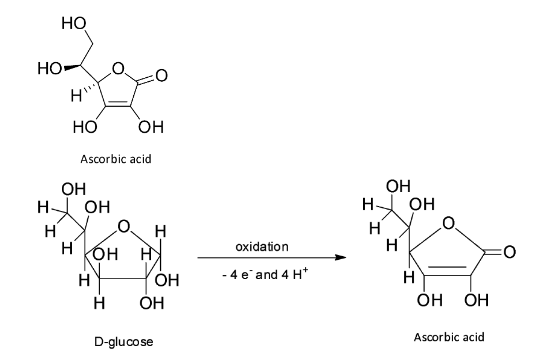
Ascorbic acid resemble the structure of:
A. Vitamin A
B. Glucose
C. Cellulose
D. Vitamin D
Answer
223.5k+ views
Hint: Ascorbic acid is another name for vitamin C and it is also known as ascorbate. The name ‘ascorbic acid’ is always used to refer to the L – enantiomer of ascorbic acid as well as its oxidized forms.
Its molecular formula is ${{\text{C}}_{\text{6}}}{{\text{H}}_{\text{8}}}{{\text{O}}_{\text{6}}}$ .
Complete step by step answer:
Ascorbic acid is a vitamin which is naturally water soluble.
It is an antioxidant agent and it functions in fighting against bacterial infections, in detoxifying reactions and also in the formation of collagen in fibrous tissues.
Vitamin C is generally found in citrus and other fruits and also in some vegetables. It cannot be produced or stored by the human body and so it must be supplied in the diet.
Ascorbic acid belongs to the class of organic compounds called butenolides. These are organic compounds containing dihydrofurans with a carbonyl group present at the C-2 carbon atom. Ascorbic acid exists as a solid and is a weakly acidic compound.
It is structurally related to glucose as it is obtained from glucose.
Thus, ascorbic acid structurally resembles glucose molecules. So, B is the correct answer.

Note:
Scurvy is a disease which is caused by the deficiency of vitamin C. Thus, scurvy can be prevented by treating with vitamin C containing foods or dietary supplements.
The intake of ascorbic acid or vitamin C on a regular basis can also reduce the severity of common cold.
However, it does not appear to prevent infection. It is also not clear if the supplementation of vitamin C affects the risk of cancer or cardiovascular disease or dementia.
Its molecular formula is ${{\text{C}}_{\text{6}}}{{\text{H}}_{\text{8}}}{{\text{O}}_{\text{6}}}$ .
Complete step by step answer:
Ascorbic acid is a vitamin which is naturally water soluble.
It is an antioxidant agent and it functions in fighting against bacterial infections, in detoxifying reactions and also in the formation of collagen in fibrous tissues.
Vitamin C is generally found in citrus and other fruits and also in some vegetables. It cannot be produced or stored by the human body and so it must be supplied in the diet.
Ascorbic acid belongs to the class of organic compounds called butenolides. These are organic compounds containing dihydrofurans with a carbonyl group present at the C-2 carbon atom. Ascorbic acid exists as a solid and is a weakly acidic compound.
It is structurally related to glucose as it is obtained from glucose.
Thus, ascorbic acid structurally resembles glucose molecules. So, B is the correct answer.

Note:
Scurvy is a disease which is caused by the deficiency of vitamin C. Thus, scurvy can be prevented by treating with vitamin C containing foods or dietary supplements.
The intake of ascorbic acid or vitamin C on a regular basis can also reduce the severity of common cold.
However, it does not appear to prevent infection. It is also not clear if the supplementation of vitamin C affects the risk of cancer or cardiovascular disease or dementia.
Recently Updated Pages
JEE General Topics in Chemistry Important Concepts and Tips

JEE Extractive Metallurgy Important Concepts and Tips for Exam Preparation

JEE Atomic Structure and Chemical Bonding important Concepts and Tips

JEE Amino Acids and Peptides Important Concepts and Tips for Exam Preparation

Electricity and Magnetism Explained: Key Concepts & Applications

JEE Energetics Important Concepts and Tips for Exam Preparation

Trending doubts
JEE Main 2026: City Intimation Slip Expected Soon, Application Form Closed, Exam Dates, Syllabus & Eligibility

JEE Main 2026 Application Login: Direct Link, Registration, Form Fill, and Steps

Understanding the Angle of Deviation in a Prism

How to Convert a Galvanometer into an Ammeter or Voltmeter

Ideal and Non-Ideal Solutions Explained for Class 12 Chemistry

Hybridisation in Chemistry – Concept, Types & Applications

Other Pages
NCERT Solutions For Class 12 Chemistry Chapter 1 Solutions - 2025-26

Solutions Class 12 Chemistry Chapter 1 CBSE Notes - 2025-26

JEE Advanced Marks vs Ranks 2025: Understanding Category-wise Qualifying Marks and Previous Year Cut-offs

Biomolecules Class 12 Chemistry Chapter 10 CBSE Notes - 2025-26

NCERT Solutions for Class 12 Chemistry Chapter 2 Electrochemistry

NCERT Solutions For Class 12 Chemistry Chapter 10 Biomolecules - 2025-26




